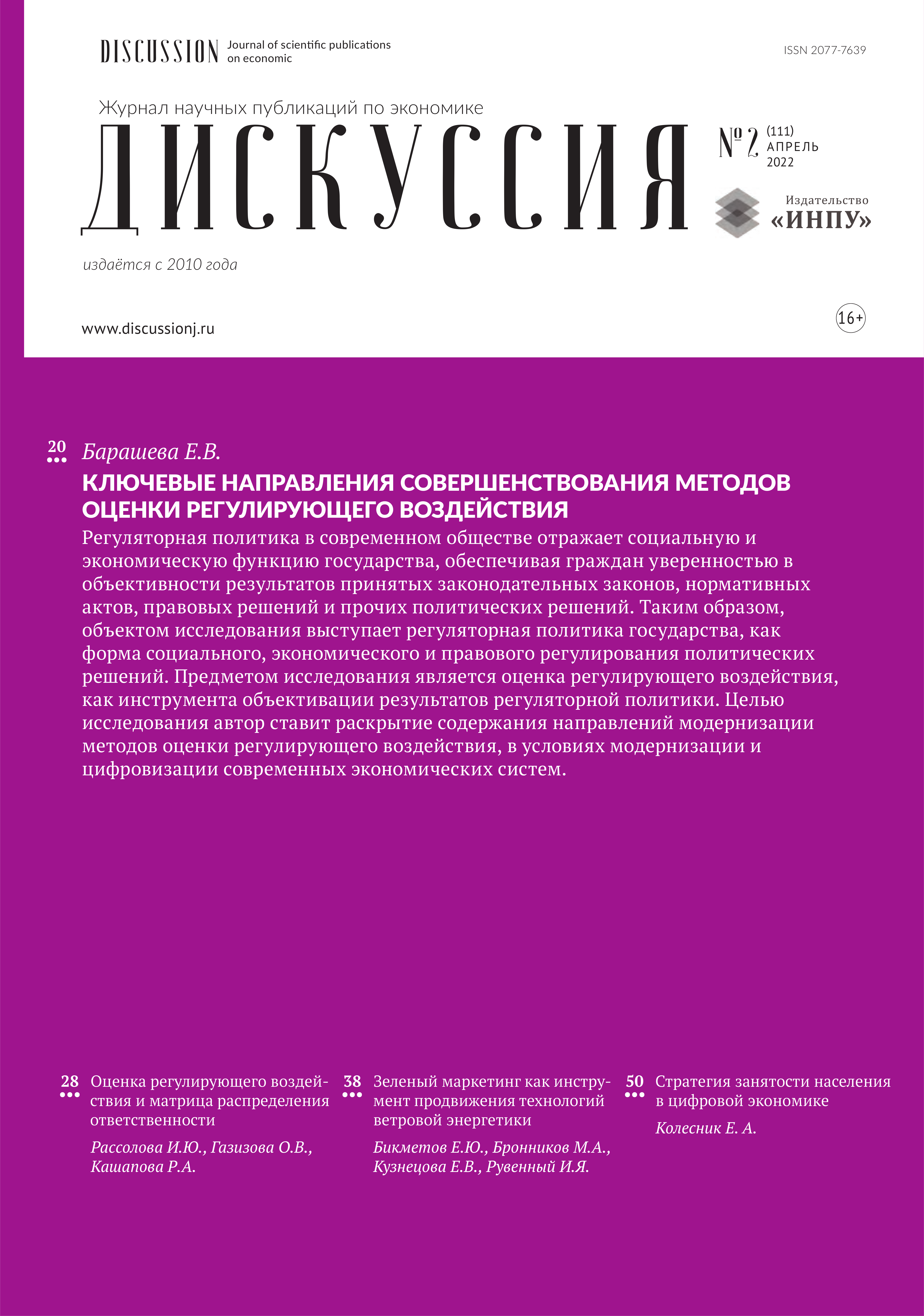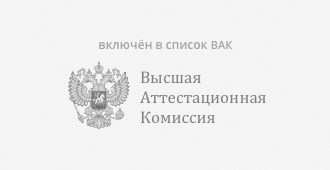Key areas of improvement of regulatory impact assessment methods
Keywords:
Regulatory policy, socio–economic consequences, Venn diagram, stakeholder analysis, social impact assessmentAbstract
Regulatory policy in modern society reflects the social and economic function of the state, providing citizens with confidence in the objectivity of the results of adopted legislative laws, regulations, legal decisions and other political decisions. Thus, the object of the study is the regulatory policy of the state as a form of social, economic and legal regulation of political decisions. The subject of the study is the assessment of regulatory impact as a tool for objectification of the results of regulatory policy. The purpose of the study is to reveal the content of the directions of modernization of methods for assessing regulatory impact, in the conditions of development and digitalization of modern economic systems. Research objectives: 1. Study of Russian and foreign results of scientific research; 2. Heuristic analysis of the subject area of research; 3. Scientific theoretical analysis and synthesis of the subject area; 4. Formulation of scientifically based research results; 5. Formulation of conclusions and proposals. The methodology of the research consists in using a theoretical-heuristic approach, which is conditioned by the extrospective methods of scientific cognition. Research results: 1. the content of regulatory impact assessment as a set of procedures is presented; 2. The procedure for analyzing stakeholders and the Venn diagram are presented; 3. The algorithm for assessing social impact is presented.
Downloads
Metrics
References
Ефремов А. А. Оценка регулирующего воздействия в системе институтов повышения эффективности нормотворчества //Вопросы государственного и муниципального управления. – 2012. – №. 2. – С. 121-133.
Филатов В. В., Рукина И. М. Оценка регулирующего влияния - как эффективный механизм развития инновационного предпринимательства //Научный журнал НИУ ИТМО. Серия «Экономика и экологический менеджмент». – 2014. – №. 2. – С. 31.
Брюханова Н. В., Фадейкина Н. В. Оценка регулирующего воздействия как ключевой элемент региональной финансовой политики //Сибирская финансовая школа. – 2015. – №. 4. – С. 46-50.
Абучакра Р., Хури М. Эффективное правительство для нового века. – Litres, 2022.
Белов Г. Л. О ВЛИЯНИИ РЕГУЛЯТОРНОЙ ПОЛИТИКИ НА СОЦИАЛЬНО-ЭКОНОМИЧЕСКОЕ РАЗВИТИЕ РЕГИОНА //КАЗАНСКИЙ ЭКОНОМИЧЕСКИЙ ВЕСТНИК № 2 (52). – 2021. – С. 45-47.
Иванова М. В. Модели и методы оценки регулирующего воздействия в государственном управлении России и зарубежных стран /. – СПб.: Изд-во СПбГЭУ, 2018. – 95 с.
Jacob K. Regulatory Impact Assessment and Sustainable Development: Towards a Common Framework? //European Journal of Risk Regulation. – 2010. – Т. 1. – №. 3. – С. 276-280. DOI: 10.1017/S1867299X00000489.
Vanclay, Frank "International Principles for Social Impact Assessment: their evolution". Impact Assessment and Project Appraisal. 21 (1): 3–4.-2003.-DOI: 10.3152/147154603781766464.
Tilt B., Braun Y., He D. Social impacts of large dam projects: A comparison of international case studies and implications for best practice //Journal of environmental management. – 2009. – Т. 90. – С. S249-S257.-DOI:10.1016/j.jenvman.2008.07.030.
Dendena B., Corsi S. The Environmental and Social Impact Assessment: a further step towards an integrated assessment process //Journal of cleaner production. – 2015. – Т. 108. – С. 965-977. DOI: 10.1016/j.jclepro.2015.07.110.
Ketema, D.M.; Chisholm, N.; Enright, P. Chapter 20: Examining the Characteristics of Stakeholders in Lake Tana Sub-basin Resource Use, Management and Governance. In Stave, K.; Goshu, G.; Aynalem, S. (eds.). Social and Ecological System Dynamics. Springer. - 2017-с. 318.- ISBN 9783319457550.
DeGeorge, R.T. Business Ethics. Pearson Education, Inc. 2010.-с. 192.- ISBN 9780205015108.
«Guidelines and Principles for Social Impact Assessment». Impact Assessment. 12 (2): 107–152. June 1994 DOI::10.1080/07349165.1994.9725857.
Henderson D. W. Venn diagrams for more than four classes //The American Mathematical Monthly. – 1963. – Т. 70. – №. 4. – С. 424-426. DOI: 10.2307/2311865.
Downloads
Published
How to Cite
Issue
Section
Categories
License
Copyright (c) 2022 Е. В. Барашева

This work is licensed under a Creative Commons Attribution-NonCommercial-NoDerivatives 4.0 International License.
Авторы, публикующие произведения в журнале «Дискуссия», соглашаются со следующими условиями:
- Авторы сохраняют за собой авторское право и предоставляют журналу право первой публикации произведения, одновременно лицензированной в соответствии с лицензией Creative Commons Attribution, позволяющей другим лицам пользоваться произведением с подтверждением авторства и первоначальной публикации в журнале «Дискуссия».
- Авторы вправе заключать с иными лицами лицензионные договоры на условиях простой (неисключительной) лицензии на использование опубликованного в журнале «Дискуссия» произведения (например, размещение его в базах данных университетов, публикация в книге), со ссылкой на его оригинальную публикацию в этом журнале.
- Автор гарантирует, что является правообладателем всех материалов, предоставляемых в редакцию, и что исключительные права на данные материалы не переданы или не предоставлены другим лицам.
- Авторам разрешено и рекомендуется размещать свое произведение в Интернете до и во время процесса подачи, поскольку это может привести к продуктивному обмену, а также к более раннему и более широкому цитированию опубликованных работ.
С момента загрузки произведения и сопроводительных материалов через раздел "Отправка материалов", автор полностью и безоговорочно принимает (акцептует) публичную оферту о заключении авторского соглашения об опубликовании произведения. В соотвтетствии с этим соглашением автор предоставляет издателю на безвозмездной основе неисключительную лицензию на использование созданного автором произведения.
С момента получения произведения и прилагаемых к нему материалов журнал "Дискуссия" вправе использовать полученные произведения без ограничений по своему усмотрению и в пределах всего срока действия исключительных прав, но с обязательным указанием имени автора (авторов) произведения, в том числе публиковать произведения (полностью или в сокращении) на территории всего мира, переводить на другие языки, направлять в репозитории научной информации, размещать в сети Интернет и использовать другими законными способами.









